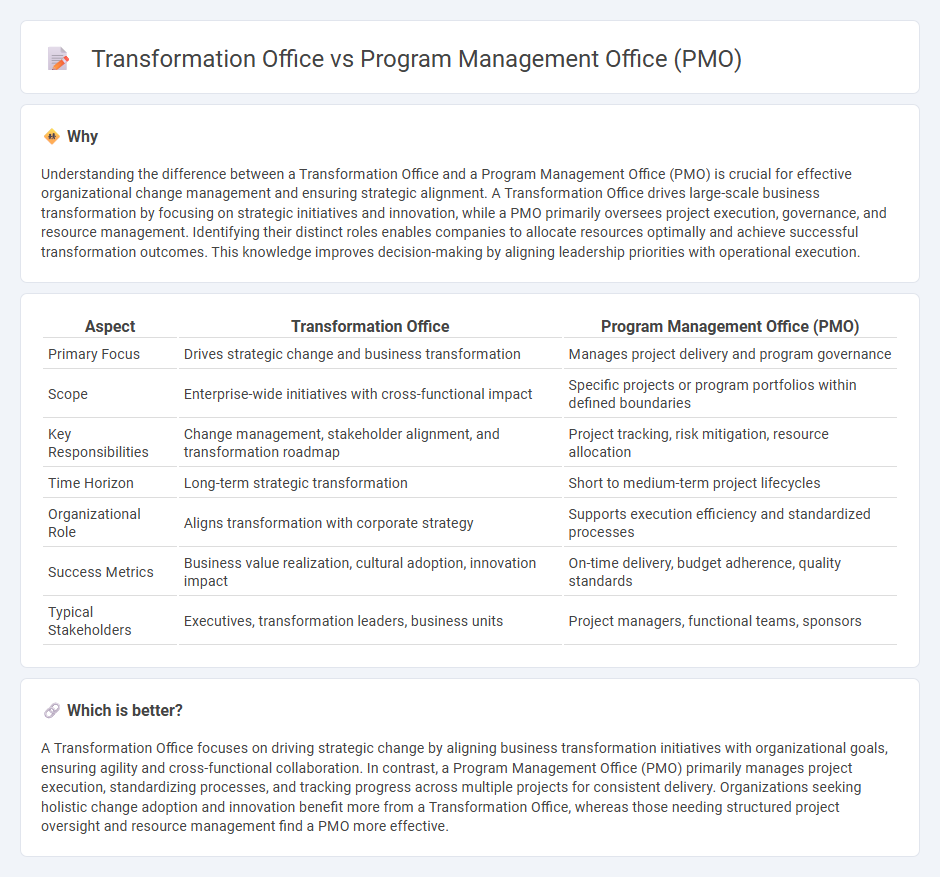
A Transformation Office focuses on driving strategic change initiatives by aligning business objectives with operational execution, ensuring sustainable organizational growth. In contrast, a Program Management Office (PMO) standardizes project management practices, monitors progress, and manages resources across multiple projects to achieve efficiency and consistency. Explore the distinct roles and benefits of both to optimize your organizational transformation and project delivery.
Why it is important
Understanding the difference between a Transformation Office and a Program Management Office (PMO) is crucial for effective organizational change management and ensuring strategic alignment. A Transformation Office drives large-scale business transformation by focusing on strategic initiatives and innovation, while a PMO primarily oversees project execution, governance, and resource management. Identifying their distinct roles enables companies to allocate resources optimally and achieve successful transformation outcomes. This knowledge improves decision-making by aligning leadership priorities with operational execution.
Comparison Table
| Aspect | Transformation Office | Program Management Office (PMO) |
|---|---|---|
| Primary Focus | Drives strategic change and business transformation | Manages project delivery and program governance |
| Scope | Enterprise-wide initiatives with cross-functional impact | Specific projects or program portfolios within defined boundaries |
| Key Responsibilities | Change management, stakeholder alignment, and transformation roadmap | Project tracking, risk mitigation, resource allocation |
| Time Horizon | Long-term strategic transformation | Short to medium-term project lifecycles |
| Organizational Role | Aligns transformation with corporate strategy | Supports execution efficiency and standardized processes |
| Success Metrics | Business value realization, cultural adoption, innovation impact | On-time delivery, budget adherence, quality standards |
| Typical Stakeholders | Executives, transformation leaders, business units | Project managers, functional teams, sponsors |
Which is better?
A Transformation Office focuses on driving strategic change by aligning business transformation initiatives with organizational goals, ensuring agility and cross-functional collaboration. In contrast, a Program Management Office (PMO) primarily manages project execution, standardizing processes, and tracking progress across multiple projects for consistent delivery. Organizations seeking holistic change adoption and innovation benefit more from a Transformation Office, whereas those needing structured project oversight and resource management find a PMO more effective.
Connection
The transformation office aligns strategic initiatives with organizational goals, driving change management and ensuring successful project execution across departments. The Program Management Office (PMO) provides structured governance, standardized processes, and resource allocation to support portfolio delivery within transformation efforts. Both entities collaborate to optimize project outcomes, enhance stakeholder communication, and ensure alignment between business transformation objectives and program execution.
Key Terms
Governance
The Program Management Office (PMO) primarily governs project execution by standardizing processes, tracking progress, and ensuring alignment with strategic objectives. In contrast, the Transformation Office focuses on steering organizational change initiatives, embedding governance frameworks that facilitate cultural shifts and operational redesigns. Explore the distinctions and governance strategies of PMOs and Transformation Offices to optimize your organizational change management.
Change Management
The Program Management Office (PMO) primarily oversees project execution, ensuring alignment with strategic goals through standardized processes and resource management, while the Transformation Office drives organizational change by focusing on change management strategies that facilitate cultural shifts and stakeholder engagement. Change management within a PMO often targets project-specific adoption, whereas the Transformation Office addresses broader, enterprise-wide transformation initiatives involving sustained behavioral change and innovation adoption. Explore detailed strategies on how these offices can collaborate to optimize change management effectiveness.
Strategic Alignment
A Program Management Office (PMO) primarily focuses on executing projects efficiently and ensuring alignment with predefined strategic goals through standardized processes and resource management. In contrast, a Transformation Office drives broader organizational change, emphasizing strategic alignment by steering initiatives that reshape business models, culture, and capabilities for long-term value creation. Explore the critical differences in strategic alignment between PMOs and Transformation Offices to optimize your organizational change efforts.
Source and External Links
Project management office - A PMO is a department within an organization that defines and maintains project management standards, aiming to standardize processes and improve project success rates through documentation, guidance, and metrics.
What is a PMO? - A PMO can be a project, programme, or portfolio management office that supports projects by providing deployment support, process improvement, and resource flexibility, and it may be organized as embedded, central, or hub-and-spoke models.
Project Management Office (PMO) - The Ultimate Guide - A PMO consists of roles like project managers, program managers, and portfolio managers who oversee planning, execution, and alignment of projects and programs with organizational strategy.
 dowidth.com
dowidth.com